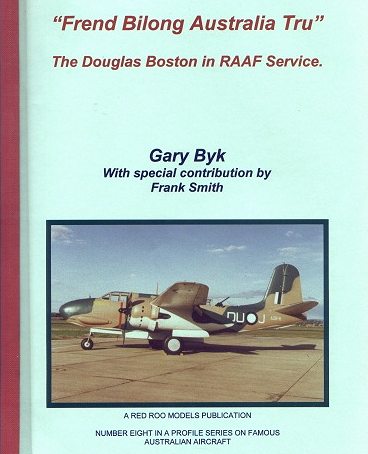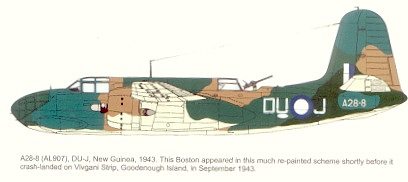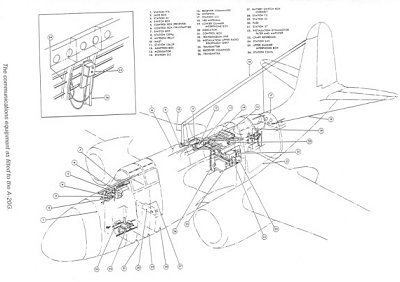 Introduction.
Introduction.|
Title: |
"Frend Bilong
Australia Tru": |
|
Author: |
Gary Byk |
|
Publisher |
Red Roos |
|
Price |
AUD $25.00 |
|
Reviewer: |
|
| Notes: |
 Introduction.
Introduction.
This book is number 8 in a series of aircraft monographs, concentrating on aircraft that served with the Royal Australian Air Force (RAAF), prepared by Red Roo Models. The series to date covers the P-39, Buffalo, Kingfisher, Kiowa, Mustang, Mirage and a book on understanding RAAF colour schemes. The books are specially written with both the modeller and enthusiast in mind, covering not only the history of the aircraft, but also tips for building the relevant models. Anyone interested in RAAF aircraft of WWII, or the Boston/A-20 family of aircraft, should be interested in this book. The book is available from Red Roo Models ( http://www.redroomodels.com.au ), for $25.00AUD, with postage charged at cost.
History.
The Douglas Boston/A-20 series of aircraft were twin-engined, monoplane light/attack bombers. First produced as a private venture by the Douglas Aircraft Corporation, they were initially ordered by the French, British and Dutch airforces. They later went on to serve throughout the world, in the inventories of all the major, and some minor, Allied powers. There's a brief but detailed history of the aircraft in the book as well as a detailed history of No 22 Squadron, RAAF- the only Australian squadron to use the Boston/A-20 in combat.
Format.
The book is in a soft-bound, A4 format and contains 122 pages. Each copy is individually numbered and signed by the author and the book first appeared in 2000. Obviously the work of a "desk top publisher", this is nevertheless a well-made and study addition to my library. While it would be nice to see the book in hard-cover format, the probable cost of such means I probably couldn't afford to buy it. By staying with the desk-top publishing method, Red Roo have made the book available to anyone who wants it, at a reasonable price.
Contents.
Unlike their P-39 book, this book by Red Roo contains a mass of coloured photographs and drawings. Gary and Red Roo have obviously made the most use of current desk-top publishing techniques to ensure as much colour as possible is included.
The
book is broken up into nine chapters and three annexes. These cover:
·
The history of the
aircraft,
·
The "Boston
Anatomy",
·
A history of how the
Boston entered Australian service,
·
The history of 22
Squadron RAAF,
·
Boston camouflage
and markings in RAAF service (with some photo's of other nations' aircraft),
·
Building the
available models,
·
A gallery and a
folio of plans and aircraft service cards.
The annexes cover the markings and colours used, the service history of each aircraft, a potted history of Flight Lieutenant Bill Newton (who won a Victoria Cross while flying one of these aircraft) and a list of the squadron's CO's.
For modellers the book is a mine of information. Gary discusses what the actual colours were that were used on the Boston, laying to rest the old "Dark Green, Dark Earth and Sky Type S" myth. The colours formulated by DuPont are referred to, as is the practice of patching the aircraft and painting with whatever colour was "close enough". There's a discussion on what paints were actually applied by the manufacturer, what the RAAF regulations called for and what the maintenance people eventually put on the aircraft (which, at times, are three completely different things) once it was in service.
 The colour
profiles show aircraft with up to three different greens being used on the one
airframe, for example, and more have DuPont "Sky Gray" undersides than "Sky Type
S". While helpful, the low tonal differences of the greens in the colour
profiles mean you'll need to look at them under sunlight, if possible, or a very
good artificial light. 12 different port side profiles are in the book, showing
colour schemes for 9 different "three colour" aircraft, one A-20C that can be
built "as is" using the AMT kit, and 2 A-20G's in Olive Drab and Neutral Grey
(OD&NG). As well there's a starboard side profile of DU-Q to match the
port-side profile. Plan views showing the "regulation" camouflage schemes are
also included.
The colour
profiles show aircraft with up to three different greens being used on the one
airframe, for example, and more have DuPont "Sky Gray" undersides than "Sky Type
S". While helpful, the low tonal differences of the greens in the colour
profiles mean you'll need to look at them under sunlight, if possible, or a very
good artificial light. 12 different port side profiles are in the book, showing
colour schemes for 9 different "three colour" aircraft, one A-20C that can be
built "as is" using the AMT kit, and 2 A-20G's in Olive Drab and Neutral Grey
(OD&NG). As well there's a starboard side profile of DU-Q to match the
port-side profile. Plan views showing the "regulation" camouflage schemes are
also included.
The use of colour doesn't end there, though. Also included are 24 colour photo's of a restored Boston III (DU-J, A28-8) and A-20G, showing interior shots of the gunner's stations, cockpit area, wheel wells, etc. So you have the benefit of a colour "walk around guide" to the aircraft. I'm no expert on the aircraft (nor any aircraft) but there's a couple that may have been mis-captioned, such as the "A-20C" on page 70 that looks like a Boston III, and the three-gun-nosed A-20C on page 43 that's said to have four guns in the caption.
As well as the colour photo's, there's numerous scale plans, B&W photo's of the various Boston marks in service with the RAAF (and a few of other nations' aircraft) and reproductions of RAAF manuals' photo's of the cockpit area, identifying the instruments, knobs and lever in the "office".
 The chapter
on the various models that have been made of the Boston/A-20 family also deals
with the after-market accessories and decals for the different 1/72 and 1/48
scale kits. The shortcomings of the various kits are described, as well as
suggested fixes to overcome them. There's also notes on the necessary
modifications needed to make an early Boston, with tropical cowls. In this
section Gary mentions a template that can be used to modify the cowls on the
1/48 AMT kit- but you'll look for it in vain. Just as the book was being
published the owner of the template withdrew permission to use it- great timing,
whoever you were! There's also a handy hint on how to replicate the bulged nose
panels that were a feature of the aircraft.
The chapter
on the various models that have been made of the Boston/A-20 family also deals
with the after-market accessories and decals for the different 1/72 and 1/48
scale kits. The shortcomings of the various kits are described, as well as
suggested fixes to overcome them. There's also notes on the necessary
modifications needed to make an early Boston, with tropical cowls. In this
section Gary mentions a template that can be used to modify the cowls on the
1/48 AMT kit- but you'll look for it in vain. Just as the book was being
published the owner of the template withdrew permission to use it- great timing,
whoever you were! There's also a handy hint on how to replicate the bulged nose
panels that were a feature of the aircraft.
A minor bit of trivia. One of the tables in the back of the book gives Australian Army, RAAF and Royal Australian Navy rank equivalents. Though correct for before 1997, after that date a RAAF Flight Sergeant ranks with an Army Warrant Officer Class 2 while an Army Lance Corporal out-ranks RAAF Leading Aaircraftsman/woman and RAN Able Seaman, being defined as an NCO rank in the Defence Force Discipline Act.
Conclusion.
Is the book worth the $25.00 price? I'd say definitely. Those who want to build a slightly different model from the usual USAAF offerings are spoiled for choice with the subjects that are covered. There's "three colour" Bostons showing up to five camouflage colours on the aircraft, A-20C's in OD&NG, Foliage Green over NG or OD over Night colour schemes and, of course, a couple of well-worn OD&NG A-20G's, one with plenty of Foliage Green patch paint on it.
The only minor quibble I have is that the A-20C gets scant attention in the book. As the AMT kit can be built, from the box, to represent one of these aircraft, a little more attention could have been paid to this version. As a rather inept modeller, I was particularly interested in looking for an aircraft I could build with a minimum amount of necessary (and probably destructive) conversion work. There are two good B&W photo's of A-20C's in the book, and a profile that shows A28-30 with a single-stack exhaust, though the text describes it as having the multi-stack exhausts as offered in the AMT kit. But these are minor quibbles and don't detract from the overall worth of the book.
Thoroughly recommended!
Review copy courtesy of my long-suffering wife.
If you would like your product reviewed fairly and quickly by a site that has well over 150,000 visitors a month, please contact me or see other details in the Note to Contributors.